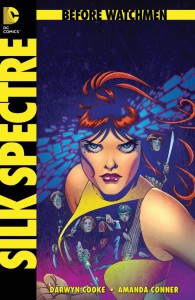 Simply put, and without question: Silk Spectre #2 is the best issue of Before Watchmen so far.
Simply put, and without question: Silk Spectre #2 is the best issue of Before Watchmen so far.
It does everything you’d expect from a Watchmen prequel book, particularly one that isn’t endorsed by the original creators: it follows the original book’s visual, nine-panel format, it pays homage to Moore’s original writing style of having the words directly reflect the visuals in the panel, and it expands the Watchmen universe by exploring niche, side subjects that it would never occur to me to wonder about until I saw those explorations here. By mining the original work’s edges while paying tribute to its written and drawn style, it does what a prequel should do: build upon the original without superceding it. It is the first Before Watchmen book that I plainly and simply liked.
This issue picks up after the events of Silk Spectre #1, with Laurie having run away from home with new boyfriend Greg to San Francisco in the Summer of Love. As within any story set in Haight-Ashbury in 1968, Laurie is living in a communal house and working a menial job, living in sin with Greg (yay, Amanda Conner-drawn boobies!) and buying into the whole Make Love Not War philosophy… up to a point. Because she has decided, in good communist fashion, to give back to the community by working as a costumed adventurer and stomping the shit out of dirty drug dealers at night. It reminds me of my own community service of storming into bars and making beer safe for children by turning it into urine, but I digress.
By going the 1960s drug culture route, Conner and co-writer Darwyn Cooke dive into an area of the Watchmen universe that I didn’t know I was interested in knowing more about: the Knot-Tops and their predilection for the drug KT’s, or “katies,” that indirectly led to the murder of the original Nite Owl in the original Watchmen. The Knot-Tops and their drug of choice was something in Moore’s Watchman that was just something that was part of the landscape that I took for granted, like electric, egg-shaped cars and cigarettes that used giant balls of tobacco. After 25 years of reading Watchmen at least once or twice a year, it never occurred to me to wonder about where that drug and its culture came from. So where writers of other Before Watchmen books have apparently generally decided to make their mark by fucking around with key character traits and plot points, Conner and Cooke have expanded something that I legitimately never wondered about, and in doing do have filled out the original work without stepping on it.
From a visual standpoint, this is as close to a Dave Gibbons / Alan Moore written book as you could hope for. Conner sticks with the original Watchman nine-panel grid as she did in the first issue, and which none of the other books have used as of yet. And as in the first issue, when Laurie is remembering or fantasizing, the panel borders become ephemeral, and the art sometimes crosses the panel borders, which while being a departure from Gibbons’s work, clearly delineates Laurie’s internal life and her external reality. But where the book shines is when Conner and Cooke choose to use the words in the panel to mirror what’s happening in the panel. Like in the page two panel where Laurie narrates, in a letter to her mom, “But I felt really chained down,” while a goon throws a chain around Laurie’s neck, or she says, “I’m not doing this for kicks,” while throwing a kick at another hired thug.
In addition, there are several panels that are clearly drawn as from Laurie’s point of view, or the point of view of someone Laurie is attacking, which really calls back to Gibbons’s original style – think when The Comedian was grabbing Moloch’s robe and snarling directly at the reader in Watchmen #2. Throw in some really well-done stylized business / storefront logos – look at the Sand Doze marquis and try not to see the stylistic similarities to the Gunga Diner storefront – as well as some smiley-faced pins and the buddha pyramid poster from Watchmen, and you have a book that just looks like it’s Watchmen, despite Conner’s more cartoony, manga-eyed style of drawing.
This isn’t one of my longer reviews, but it doesn’t need to be. The fact of the matter is that, for the first time in six weeks of Before Watchmen, one creative team has gotten the feel of the original down, both written and visually. It expands the character it’s exploring without contradicting anything we’ve seen before, and it chooses an area of the original to explore that is interesting in a way I never thought would be, and that expands the original in a very specific area that doesn’t affect it in any negative way. The storytelling here is an homage to the original that doesn’t get in its way. Even for Watchmen originalists, this is a book that will call back to the original without sullying it in any way.
For the first time, Silk Spectre #2 is a Before Watchmen book that is highly recommended.
 Podcast RSS Feed
Podcast RSS Feed iTunes
iTunes Google Play
Google Play Stitcher
Stitcher TuneIn Radio
TuneIn Radio Android
Android Miro Media Player
Miro Media Player Comics Podcast Network
Comics Podcast Network